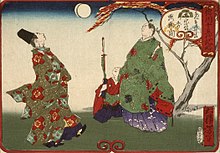
Back كيماري (رياضة) Arabic Kemari Catalan Kemari Czech Kemari Esperanto Kemari Spanish Kemari Finnish Kemari French Կեմարի Armenian Kemari ID Kemari Italian




Kemari (蹴鞠) is an athletic game that was popular in Japan during the Heian (794–1185) and Kamakura period (1185–1333). It resembles a game of keepie uppie or hacky sack. The game was popular in Kyoto, the capital, and the surrounding Kinki (Kansai region), and over time it spread from the aristocracy to the samurai class and chōnin class. Nowadays, kemari is played as a seasonal event mainly at Shinto shrines in the Kansai region, and players play in a costume called kariginu (ja:狩衣), which was worn as everyday clothing by court nobles during the Heian period.[1]
© MMXXIII Rich X Search. We shall prevail. All rights reserved. Rich X Search